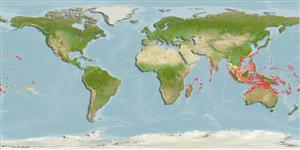Environment: milieu / climate zone / depth range / distribution range
Écologie
marin récifal; profondeur 1 - 50 m (Ref. 9710), usually 1 - 50 m (Ref. 27115). Tropical; 24°C - 28°C (Ref. 27115); 30°N - 30°S, 30°E - 89°W
Indo-pan-Pacific: East Africa to the Galapagos Is. north to southern Japan, south to the southern Great Barrier Reef and New Caledonia, Tuamotus, throughout Micronesia
Taille / Poids / Âge
Maturity: Lm ? range ? - ? cm
Max length : 60.0 cm TL mâle / non sexé; (Ref. 3145)
Épines dorsales (Total) : 6; Rayons mous dorsaux (Total) : 26 - 27; Épines anales: 3; Rayons mous anaux: 27 - 29. Adults develop a convexly rounded prominent snout and unusually tall dorsal and anal fins. Side of body with vertical blue lines which break up into small blue spots dorsally and ventrally. A broad blue band extending from eye to front of rostral protuberance (Ref 9808).
Occurs in deep lagoon and seaward reefs. Found forming loose schools along upper regions of deep drop-offs (Ref. 48637). Forms mid-water aggregations off steep slopes during the day to feed on zooplankton. Usually found alone or in pairs. Omnivorous. Has the ability to show or hide its blue markings (Ref. 9710). Minimum depth reported taken from Ref. 27115.
Life cycle and mating behavior
Maturities | Reproduction | Spawnings | Egg(s) | Fecundities | Larves
Myers, R.F., 1991. Micronesian reef fishes. Second Ed. Coral Graphics, Barrigada, Guam. 298 p. (Ref. 1602)
Statut dans la liste rouge de l'IUCN (Ref. 130435)
Menace pour l'homme
Harmless
Utilisations par l'homme
Pêcheries: intérêt commercial mineur; Aquarium: Commercial
Outils
Articles particuliers
Télécharger en XML
Sources Internet
Estimates based on models
Preferred temperature (Ref.
123201): 25.5 - 29, mean 27.6 °C (based on 684 cells).
Phylogenetic diversity index (Ref.
82804): PD
50 = 0.5000 [Uniqueness, from 0.5 = low to 2.0 = high].
Bayesian length-weight: a=0.02630 (0.01537 - 0.04500), b=3.01 (2.86 - 3.16), in cm total length, based on LWR estimates for this species & Genus-body shape (Ref.
93245).
Niveau trophique (Ref.
69278): 2.2 ±0.11 se; based on food items.
Generation time: 4.2 ( na - na) years. Estimated as median ln(3)/K based on 1
growth studies.
Résilience (Ref.
120179): Faible, temps minimum de doublement de population : 4,5 à 14 années (K=0.264; Tmax=45).
Fishing Vulnerability (Ref.
59153): Moderate vulnerability (38 of 100).
Nutrients (Ref.
124155): Calcium = 34.7 [21.4, 64.1] mg/100g; Iron = 0.542 [0.278, 0.926] mg/100g; Protein = 18.7 [17.6, 19.8] %; Omega3 = 0.121 [0.078, 0.223] g/100g; Selenium = 38.2 [20.7, 66.3] μg/100g; VitaminA = 47.4 [15.4, 143.7] μg/100g; Zinc = 1.36 [0.95, 1.93] mg/100g (wet weight);
